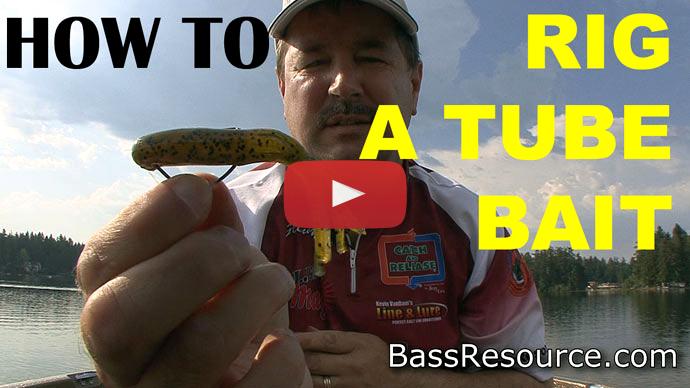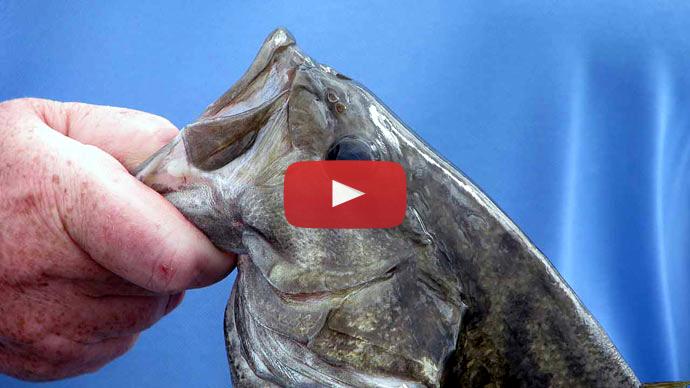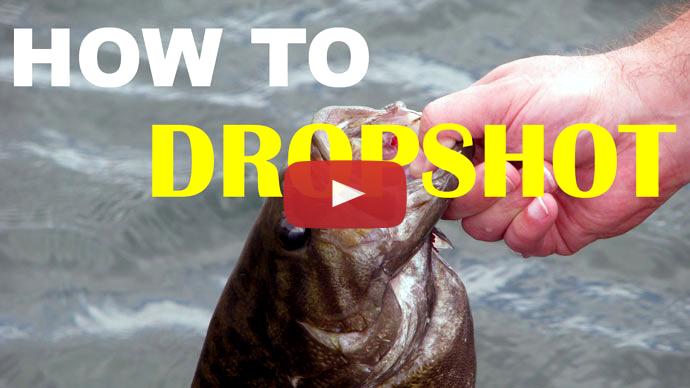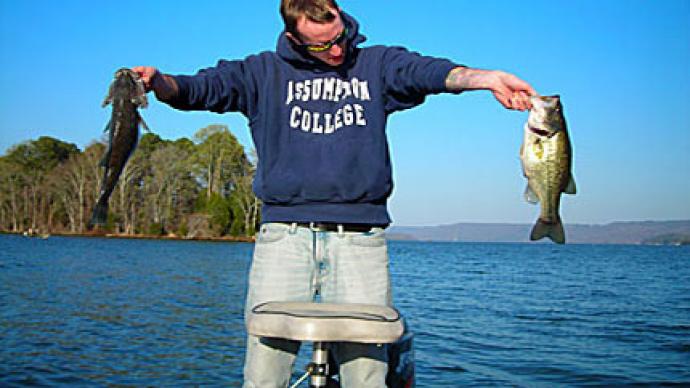Oh! I got one! There we go. Nice. He liked my drop shot tube. There we go. Get him to the boat. He's all kinds of mad. Here we are you.
Look at this guy. He liked my drop shot tube.
Today I'm gonna show you what kind of gear to use, how to rig it. And then I'm gonna take you on the water and show you the different techniques you can use to catch fish with a dropshot tube.
Hey, folks. Glenn May here with BassResource.com. Today, I want to talk to you about drop shotting a tube. Yeah, a tube jig. This is it. This is what we're talking about. Now, if you're not sure how to rig this, I've got a video here on how to do it. It's linked underneath this video. You can take a look at that and how to rig all this up. And today, though, we're going to talk about all the equipment that we're going to use, the terminal tackle, and then how to fish it.
So first off, I've got the drop shot weight here and I've got it about 18 inches and then I have the hook here. Now, the reason I have so much here is during the summer months and in clearer water, you want to go with a longer leader. Because the fish, they're a little bit more off the bottom, they're a little more aggressive. The higher you get it off the bottom, they're going to come a little bit further distances to go after it. If you're fishing in dingy water or it's in the winter when they're a little more hunkered down and sticking to the bottom, then you want to shorten up that leader a bit. Maybe go to about 10 inches or so, 8 inches. But with this, in the summertime, you can go with 18 inches, maybe even 24 inches.
Keep in mind, too, also, we're throwing this out and reeling it back in, so it's going to be at an angle to the bottom of the lake. So even though you may have 18 inches here, really you don't have as much distance off the bottom that you think you do. If the bottom is, say, is right here, think about that. Instead of it being this far off the bottom, it's going to be like this. So maybe, instead of 18 inches, it's going to be more about 8 inches off the bottom. And if you have a real short leader, well, you're basically just hugging the bottom and you're not getting the benefit off of a drop shot. So I don't believe in anything less than 8 inches. Just that defeats the purpose of a drop shot.
So 18 inches here. You can go longer if you want. I'm fishing it on…so real light line, six pound test, light wire. This is only a 1/0 hook thin wire, so you don't want to use heavy line on this because you'll just straighten the wire out if you do that.
And to match it, we're using a medium, light-action spinning outfit here. Again, real light action, real limber rod tip here, so it's going to give on this light setup. Use a heavier-action rod, a medium-heavy, or something like that, then all you're going to do when you set the hook and you fight the fish back to the boat is you're just going to straighten that hook out. So matching the gear with the line and the hook, that's paramount to drop shotting. Okay, so now you know the gear and what to use. Now, let's go out and fish it.
All right. So what I have here is an area that's mostly rocky bottom with some scattered weeds. Great place to be fishing the dropshot tube. All we're going to do is we're going to cast it out there. We're not going to throw it really hard. It just takes a lob cast. Real nice and easy. If you throw it too hard, you might even throw the bait off the hook because again, we just have it nose-hooked. So it's not a real hard cast. Sometimes, even just an underhanded cast is alls it takes. Now, when you first cast it out there, you want to watch the bait as it falls. Sometimes, the fish will hit it when it falls, so pay real close attention to that line as it's entering the water as the weight is getting down toward the bottom.
If you see that line twitch, pop, jerk, do anything odd, just reel down and set the hook. And because this is an exposed hook, you don't have to set the hook really hard. You don't have to jerk it because if you do, you might even break the line or straighten out the hook. So instead, it's just a real easy hook set. You just lift. Just lift rapidly. Some people just reel really hard. Some people do a sweep set. It's not a very hard hook set, and it doesn't take much to get that light wire hooked to penetrate past the barb and you have the fish.
So here's how you fish it. You just cast it out there. And this is what I'm doing, I'm watching that line. I've flipped the bail over. I've got the rod down near the surface, or pointed down, so I'm ready to set the hook in case it gets bit.
And now when it's on the bottom, this is what I want you to do. Just reel up the slack, and then just hold it in place. Don't move it. Don't move at all. And you might think that bait isn't moving at all, but it is. Try to take your hand and hold it steady in front of you for 30 seconds, as steady as you can. There's going to be some movement. No one can hold it perfectly still. You're not a mannequin. Your hand is moving, and that movement is going to be transmitted down the rod, down the line to the bait.
In addition, in the water, there's current. Even if it's a lake, there's still current, whether it be wave action, wind-driven, something like that, but the water's always moving. It's never stagnant. That's going to move the bait as well. Light breeze, little chop on the water, that's going to be tapping against your line, and that will be transmitted to the bait as well. So it's always moving, even if you're holding still. And this is a real subtle approach. It's a methodical way to of fishing. This is how you entice a reluctant fish to bite, is just hold it in place. Hold it for as long as you can stand it. There's no real set rule, but this is a real slow, methodical way so the slower, the better. You cannot fish it too slow.
And once you want to move it, alls you want to do is just lift up on the rod tip and let it fall right back down to the bottom and then hold it steady again. Don't even move it at all.
One thing you can do is while it's sitting in there, is you might want to impart a little bit of action after you've let it sit for a while, is just shake the rod tip, just like that. Just let it bounce. It just takes a little bit of action, not much at all. And then let it stop again. Just let it sit. I can't tell you how many times you'll be sitting here and all of a sudden, your rod tip will bend. They'll just swim off with it.
You can just shake it again just a little bit, and let it sit. Sometimes, you can move the bait. What you're trying to do is shake the bait, not the weight. Keep that in mind. Shake the bait, not the weight. But even when you do that, you're still moving that bait, that weight, just a little bit, and you are moving it across the bottom. But you could also shake it when you lift up and let it drop again. But primarily I just like to do it while it's sitting there in place.
Now, the areas I'm going to fish this, they differ by the season. In the summer and in the wintertime, most of the fish are out on the main lake, they're out in deeper water. So during those times of year, I'm going to target main lake points, rocky humps. I'm going to fish rock piles. I'm fishing ledges, creek channels, dropoffs, anywhere where the creek channel swings in near the shoreline. Those are the places that I'm going to be fishing this, during those times of the year.
Now, in the spring and in the fall, the fish move up shallow to feed, so I'm going to go in the backs of coves, back of creek channels, protected bays, flats, grassy flats are one of my favorites, secondary points. Those are the type of things you'll be targeting during those times of the year.
If you do it with this outfit, again, you have to find the fish. So don't think you're going to catch a ton of fish if you haven't found them yet. But once you find them, you can pick apart that area and catch a bunch of fish. You're going to have a whole heck of a lot of fun.
For more tips and tricks like that, visit BassResource.com.




